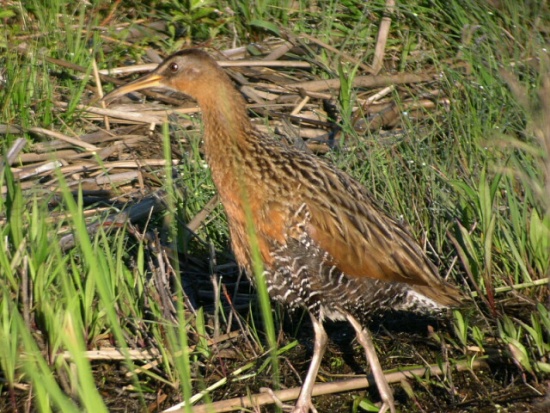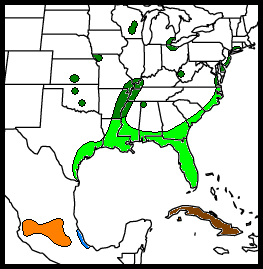- Rallus elegans
Identification
Length 35cm (14 in), wingspan 61cm (24 in)
Adult
- White undertail coverts
- Red-brown face, neck, breast and wing coverts
- White throat
- Bold black and white barring on flanks
- Dark brown cap and hindneck
- Brown back feathers with tawny edges
- Whitish belly
Juvenile
- Pale buff head and neck
- Back and upperwings darker
- White belly
Similar Species
Similar to Clapper Rail in shape and color pattern. Clapper rail tends to be smaller and grayer, and generally inhabits saltwater marshes. However, there is some overlap in physical features and habitat, and hybridization has been documented.
Virginia Rail has a long curved bill and reddish breast like the King Rail, but can be distinguished by its much smaller size, reddish bill, darker legs, and dark grey face.
Distribution
| Eastern United States, eastern Mexico, and Cuba | |
| Legend • R. e. elegans; year-round |
Habitat
Freshwater or brackish marshes and marsh-shrub swamp habitats.
Taxonomy
King Rail and Clapper Rail are closely related and are sometimes considered conspecific.
Subspecies6
- R. e. elegans - E Canada and ne US; winters to e Mexico
- R. e. tenuirostris - Central Mexico
- R. e. ramsdeni - Cuba and Isle of Youth
Behaviour
Breeding
Male announces presence within territory by giving repeated hard "kek" calls. They make nests of grass or marsh vegetation constructed just above the water in bushes or clumps of marsh vegetation. May place nest anywhere from dry ground to over more than 2 ft of water. Often nest in rice fields in southeastern states. Nests are usually domed with an entrance ramp. Six to 13 buff-coloured eggs are laid. Both sexes share in incubation and rearing responsibilities. Chicks are downy black with pied white-and-black bills upon hatching. The chicks are semi-precocial, being able to walk shortly after hatching but remaining dependent on the parents for food and protection for several weeks.
Diet
Mainly crayfish and crabs, but also includes other aquatic invertebrates, small fish, insects, and some plant seeds.
References
- Sibley, David A. 2000. The Sibley Guide to Birds. New York: Alfred A. Knopf. ISBN 9780679451228
- Poole, Alan F. et al. 2005. King Rail (Rallus elegans). The Birds of North America Online (A. Poole, Ed.). Ithaca: Cornell Lab of Ornithology; Retrieved from the Birds of North America Online: http://bna.birds.cornell.edu/bna/species/003.
- Brinkley, Edward S. 2007. Field Guide to Birds of North America. New York: Sterling Publishing Co., Inc. ISBN 9781402738746
- Howell, Steve N.G. and Sophie Webb. 1995. A Guide to the Birds of Mexico and Northern Central America. New York: Oxford University Press. ISBN 9780198540120
- Raffaele, Herbert et al. 2003. Birds of the West Indies. Princeton: Princeton University Press, 2003. ISBN 9780691113197
- Clements James F. 2007. The Clements Checklist of Birds of the World. 6th ed., with updates to October 2008. Ithaca: Cornell University Press. ISBN 9780801445019





